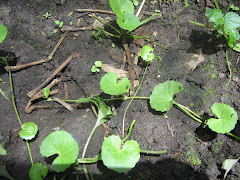
Vernacular names:-
Pegaga, Indian pennywort, hydrocotyle, daun kaki kuda, Gotu Kola, Asiatic Pennywort, Luei Gong Gen, Takip-kohol, Antanan, Pegagan, Vallarai, brahmi, Rau Ma, Kuka kud and Bai Bua Bok
Pegaga, Indian pennywort, hydrocotyle, daun kaki kuda, Gotu Kola, Asiatic Pennywort, Luei Gong Gen, Takip-kohol, Antanan, Pegagan, Vallarai, brahmi, Rau Ma, Kuka kud and Bai Bua Bok
Parts Used
 :-
:- Leaves, roots and dried whole plant
Chemical Constituents:-
-Leaves contain vellarine, triterpenes asiatic acid, madecassic acid together with triterpenoid ester glycosides known as asiatiosides and brahminoside
-Whole plant contain alkaloid, glycosides, sterols, palmitik acid, stearic acis, philandrin,tanin, sterol, saponin, lignoceric acid, linoleic acid, fatty acis, flavanoids and brahmic acid
-The volatile oil contain pcymol,caryophyllene and farnesene
Samples of the Indian plants collected from different places showed the presence  of the following glycosides:
of the following glycosides:
 of the following glycosides:
of the following glycosides:-indocentelloside
-brahmoside
-brahminoside
-asiaticoside
-thankuniside
- isothankuniside
-The corresponding triterpene acids obtained on hydrolysis of the glycosides are
indocentoic, brahmic, asiatic, thankunic and isothankunic. These acids, except the
last two, are also present in free form in the plant apart from isobrahmic and betulic
acids. The presence of mesoinositol, a new oligosaccharide, ‘centellose’, kaempferol,
quercetin and stigmasterol, have also been reported.
Pharmacological Action
(Scientifically proven)
-In term of wound healing: the triterpenoids are thought to stimulate the production of human collagen I, a protein associated with wound healing.
-Several trials are available that have shown efficacy in the treatments of wound, ulcers, burns and the prevention of scars.
-Animal experiments showed anti-inflammatory and antimicrobial activities. Small clinical studies indicate a positive action on patients with venous sufficiency
-Asiaticoside and related triterpenoids are selectively toxic to the tubulin (which forms the spindle during cell division) and as a result prevents or slows down cell division
-They are generally tonic
-Studies have shown that tablets made from this plant, when taken orally over 12 weks by mentally retarded children, produced significant capabilities in them. Madasiatic acid and brahmic acid have been isolated from the plant
Pharmacology studies conducted in India
The main active ingredients in Brahmi (pegaga)are :-
0
Bacoside A and B.
-Bacoside A assists in release of nitric oxide that allows the relaxation of the aorta and
veins, to allow the blood to flow more freely through the body. Therefore Brahmi is r
revered for strenghtening the immune system, improving vitality and performance
and promoting longevity.
-Bacoside B is a protein valued for nourishing the brain cells, as a result Brahmi
improves mental clarity, confidence, intelligence and memory recall. It has been
widely used by students and older people alike.
-Asiaticosides stimulate the reticuloendothelial system where new blood cells are
formed and old ones destroyed, fatty materials are stored, iron is metabolized, and
immune responses and inflammation occur or begin.
-The primary mode of action of Centella appears to be on the various phases of
connective tissue development, which are part of the healing process.
-Centella also increases keratinization, the process of building more skin in areas of
infection such as sores and ulcers. Asiaticosides also stimulate the synthesis of lipids
and proteins necessary for healthy skin.
Finally centella strengthens veins by repairing the connective tissues surrounding veins and decreasing capillary fragility.






No comments:
Post a Comment